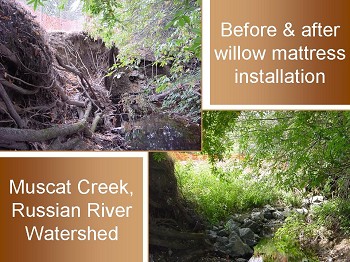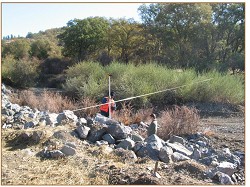Restoration Project Monitoring Method Evaluation

The California Department of Fish and Game (CDFG) administers a substantial number of stream and watershed restoration project funds within the state. Realizing the need for a systematic and consistent means of assessing project effectiveness, they contracted Richard Harris, Forest Ecology Specialist at the University of California Berkeley, to develop standard qualitative and quantitative protocols for implementation and effectiveness monitoring of stream restoration projects. Harris and his team presented a set of protocols to CDFG in 2005.
During the 2005 summer season, we field tested the implementation and effectiveness monitoring protocols outlined in Qualitative Monitoring of Fisheries Habitat Restoration at stream restoration treatment sites in Marin, Sonoma and Mendocino Counties. During the 2006 summer field season, we field tested the quantitative effectiveness monitoring protocols outlined in Monitoring the Effectiveness of Bank Stabilization Restoration and five of the seven protocols outlined in Monitoring the Effectiveness of Riparian Vegetation Restoration for usability and efficacy. The purpose of this monitoring effort was two-fold: 1) to collect data for verification of projects funded through CDFG's Fisheries Restoration Grant Program (FRGP), and 2) to field-test the protocols and provide recommended modifications and suggestions for their continued use.
The comments and recommendations that arose as a result of this monitoring effort are outlined in the following online reports:
-
Qualitative Implementation and Effectiveness Monitoring of Fisheries Habitat: A Field Evaluation of Protocols
-
Quantitative Effectiveness Monitoring of Bank Stabilization and Riparian Vegetation Restoration: A Field Evaluation of Protocols

As a final note, we drew from our experiences gained through this evaluation effort to develop Developing a Monitoring Program for Riparian Revegetation Projects .

